Optipedia • SPIE Press books opened for your reference.
Newton’s Rings
Excerpt from Field Guide to Interferometric Optical Testing
The classical Fizeau is also useful for testing concave or convex surfaces with large radii of curvature. If the surface has too much curvature the fringe frequency becomes too large and/or the OPD becomes larger than the coherence length. A convex test surface on top of a flat reference will give a Newton’s rings pattern. If the two surfaces are truly in contact at the center, then the center is always dark in reflection. This is because there is a 180° phase change for the reference beam due to the reflection at a boundary from lower index to higher index. Since the test beam has no phase change, and the OPD is zero, the two waves destructively interfere.

The radius of curvature R is found by counting the number of bright fringes to a radial distance rm, where the first bright fringe is m=0.
 The classic Fizeau interferometer is useful for checking the curvature of a lens surface versus a master surface, as in lens grinding. The surfaces match when only tilt fringes remain.
The classic Fizeau interferometer is useful for checking the curvature of a lens surface versus a master surface, as in lens grinding. The surfaces match when only tilt fringes remain.
E. P. Goodwin and J. C. Wyant, Field Guide to Interferometric Optical Testing, SPIE Press, Bellingham, WA (2006).
View SPIE terms of use.

